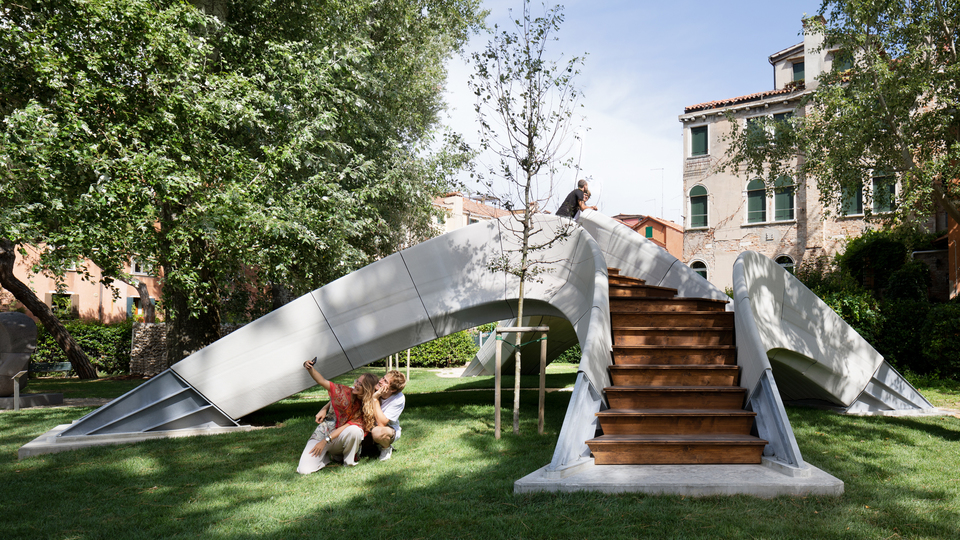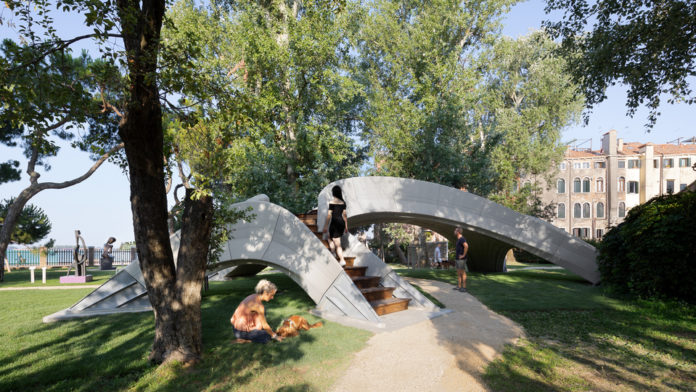ETH Zurich and Zaha Hadid Architects Computation and Design Group (ZHACODE), have worked in collaboration with incremental3D (in3D), for the development of a 3D printed concrete bridge.
Named Striatus, the development of this project has been made possible by Holcim. Unlike other 3D concrete printed bridges we have been covering in construction 3D printing, Striatus is an arched, unreinforced masonry footbridge composed of 3D-printed concrete blocks assembled without mortar.
While the name aims to reflect its structural logic and fabrication process, the 16×12-metre footbridge combines traditional techniques with advanced computational design, engineering and robotic manufacturing technologies.
From a manufacturing standpoint, concrete is printed in layers orthogonal to the main structural forces to create a “striated” compression-only funicular structure that requires no reinforcement.
Robotic 3D concrete printing
Unlike typical extrusion 3D printing in simple horizontal layers, Striatus uses a two-component (2K) concrete ink with corresponding printing head and pumping arrangement to precisely print non-uniform and non-parallel layers via a 6-axis, multi-DOF robotic arm. This new generation of 3D concrete printing in combination with the arched masonry design allows the resulting components to be used structurally without any reinforcement or post-tensioning.
The computational design-to-construction stage has been made possible through a co-development approach which implied the use of COMPAS, an open-source computational framework for collaboration and research in the AEC industry.

Strength through geometry
Striatus is an unreinforced concrete structure that achieves strength through geometry. Concrete can be considered an artificial stone that performs best in compression. In arched and vaulted structures, material can be placed precisely so that forces can travel to the supports in pure compression. Strength is created through geometry, rather than an inefficient accumulation of materials as in conventional concrete beams and flat floor slabs. This presents opportunities to significantly reduce the amount of material needed to span space as well as the possibility to build with lower-strength, less-polluting alternatives.
Sustainable digital concrete
Circular by design, Striatus places material only where needed, significantly reducing its environmental footprint. Built without reinforcement and using dry assembly without binders, Striatus can be installed, dismantled, reassembled and repurposed repeatedly; demonstrating how the three R’s of sustainability (Reduce, Reuse, Recycle) can be applied to concrete structures.
- Reduce: Lowering embodied emissions through structural geometry and additive manufacturing that minimises the consumption of resources and eliminates construction waste.
- Reuse: Improving circularity and longevity. Unlike conventional reinforced concrete structures, Striatus is designed to be dry assembled without any binder or glue, enabling the bridge to be dismantled and reused in other locations.
- Recycle: By ensuring different materials are separated and separable, each component of Striatus can easily be recycled with minimal energy and cost.
It is possible to appreciate this work of art at the Giardini della Marinaressa during the Venice Architecture Biennale until November 2021. Further information about this project can be found here.
Remember, you can post free of charge job opportunities in the AM Industry on 3D ADEPT Media or look for a job via our job board. Make sure to follow us on our social networks and subscribe to our weekly newsletter : Facebook, Twitter, LinkedIn & Instagram ! If you want to be featured in the next issue of our digital magazine or if you hear a story that needs to be heard, make sure to send it to contact@3dadept.com






